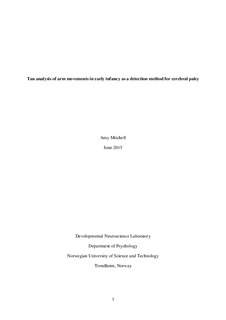| dc.description.abstract | Cerebral palsy is the most common motor disability seen in children. Physicians agree that early detection and intervention for affected children is desirable, yet current diagnostic measures rely heavily upon a child’s failure to meet normal developmental milestones, causing significant delays for diagnosis and treatment. This study set out to investigate the feasibility of using the principles of general tau theory to identify movement dysfunction in very young infants with cerebral palsy. Three potential tau-related markers were investigated in a sample of 20 infants with withheld diagnoses, 10 infants with cerebral palsy and 10 healthy control infants. Analyses focussing on one of these markers, the standard deviation of the coupling constant k, was found to distinguish between infants with and without cerebral palsy for 18 out of the 20 infants included in this study. It was also found that a threshold standard deviation of k equal to 0.30 differentiated between infants with and without cerebral palsy with a specificity of 0.80 and a sensitivity of 0.90. Furthermore, particular classifications of cerebral palsy appeared to be associated with different patterns of values across the infants’ two limbs. It was therefore concluded that analyses based in tau theory show potential to be able to quantitatively predict with high sensitivity and specificity both the presence and subtype of cerebral palsy. | nb_NO |
